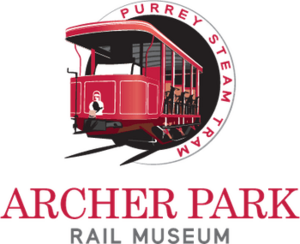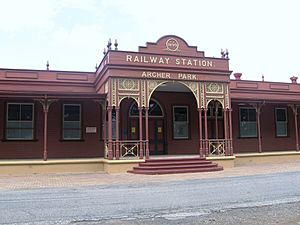Archer Park Rail Museum facts for kids
 |
|

Archer Park Railway Station and Museum, 2009
|
|
| Location | Denison Street, Rockhampton, Rockhampton Region, Queensland, Australia |
|---|---|
| Design period | 1870s–1890s (late 19th century) |
| Built | 1897–1908 |
| Architectural style(s) | Classicism |
| Official name: Archer Park Railway Station, Rockhampton Central Railway Station | |
| Type | state heritage (landscape, built) |
| Designated | 21 October 1992 |
| Reference no. | 600777 |
| Significant period | 1897–1970 (historical) 1897–ongoing (social) 1890s–1910s (fabric) |
| Significant components | loading bay/dock, trees/plantings, machinery/plant/equipment – transport – rail, office/s, carriage shade (railway), railway station, store/s / storeroom / storehouse, railway refreshment room/s, platform, furniture/fittings, track |
The Archer Park Rail Museum is a cool place to visit in Rockhampton, Australia. It used to be a busy train station called Archer Park Railway Station. Now, it's a museum where you can learn all about trains and the history of railways in Queensland.
The museum is famous for its special French Purrey steam tram. This tram was rebuilt using parts from the original trams that ran in Rockhampton between 1909 and 1939. It's a rare sight and a big highlight for visitors! The station building itself is very old, built between 1897 and 1908. It's even listed on the Queensland Heritage Register because it's so important to history.
Contents
Discovering Archer Park's Past
Archer Park Railway Station was once the main train station in Rockhampton. It played a big part in connecting people and goods across Central Queensland. The station was important for the growth of the North Coast Railway in the early 1900s.
Early Railways in Queensland
In 1863, Queensland decided to build its railways using a "narrow gauge." This meant the tracks were closer together than in other parts of Australia. The main reason for this was to save money on building costs. The first train line in Queensland opened in 1865, connecting Ipswich to Grandchester.
Rockhampton also wanted its own railway. People in the town needed a way to transport copper from the Peak Downs area. So, the first part of the Central Western railway line opened in 1867, going from Rockhampton to Westwood. This line later reached places like Emerald and Longreach.
Connecting Rockhampton's Lines
Rockhampton had two separate railway lines for a while. One went west from Stanley Street, and another went to Emu Park from North Rockhampton. There was no direct connection between them because the Fitzroy River was in the way.
In 1894, the government decided to build a deepwater port at Broadmount. This made it important to connect Rockhampton's two railway lines. A new bridge, the Alexandra Railway Bridge, was planned across the Fitzroy River. This bridge and the connecting line along Denison Street were special because they were the first double-track lines outside of the Brisbane area.
Building Archer Park Station
The Rockhampton City Council gave land in Leichhardt Park (now Archer Park) for a new central railway station. Plans for Archer Park Station were drawn up in 1897. The idea was to have a large station with a long platform and a special arched roof called a "carriage shade." This shade would protect passengers and goods from the weather.
The final plans for the station were made in 1898 by architect Henrik Hansen. He designed many railway stations, and his designs often included these large arched roofs. Construction of the Rockhampton Junction Railway, including the bridge and the Denison Street line, began in 1897.
The Archer Park station officially opened to the public on December 11, 1899. It quickly became the main station in Rockhampton, taking over from the older Stanley Street station.
A Busy Hub for Passengers
Archer Park was designed mainly for passengers, not for moving large amounts of goods. It was the starting and ending point for trains going to places like Mount Morgan, Emu Park, and Lakes Creek. Trips to the seaside at Emu Park and Yeppoon were very popular.
In 1906, the station was expanded to include a refreshment room where travelers could get food and drinks. This room opened in 1908.
One challenge for the trains was the Denison Street line. Since the tracks ran along a main street with several crossings, trains had to go very slowly, usually no more than 10 miles per hour. Firemen on the trains had to ring a hand bell to warn people of the approaching train.
Changes and Closure
By 1922, Archer Park Station was getting too small for the longer passenger and mail trains. The trains were so long that they sometimes blocked the main line. Because of this, the Stanley Street station was expanded between 1924 and 1928. It became the new main station for long-distance trains. Archer Park then handled more local services.
During World War II, Archer Park was used again to help transport soldiers. However, after the war, train services slowly decreased. Many branch lines closed, and by 1969, there were no more passenger trains running from Archer Park.
The station officially closed on February 2, 1970. For a while, it was used as a freight terminal for a door-to-door delivery service.
Becoming a Museum
Local residents were not happy about the noise from the freight activities. The Rockhampton City Council suggested turning the station into a museum. In 1990, Queensland Railways handed Archer Park Station over to the Rockhampton City Council.
Since then, the station building and carriage shed have been restored. A section of the original track remains, connecting the station to its loop line. Today, Archer Park Rail Museum is a fantastic place to explore Rockhampton's railway heritage.
Exploring the Museum Today
The Archer Park Railway Station building is made of timber and has a corrugated iron roof. The main entrance has a raised verandah with beautiful cast iron columns. Above the entrance, you can see a timber gable with "A.D. 1899 RAILWAY STATION" written on it.
The most striking feature is the huge steel-framed carriage shade. This roof covers the railway platform and the single track that remains. It used to cover more tracks when the station was busy. Inside the station, you can see the old ticket windows, offices, and even the signal box with its control levers.
The museum also has a driveway and parking area. There are trees around the property, and the carriage shade area is now enclosed. A section of the original main line track is still visible in front of the station.
Heritage Significance
Archer Park Railway Station is important for many reasons:
- It shows how the railway network grew in central Queensland and Rockhampton.
- The double line along Denison Street is a rare example in Australia of road and rail traffic sharing the same space.
- It's a great example of a main line railway station from the turn of the century.
- The curved carriage shade is a special design feature by architect Henrik Hansen.
- The station is still very much like it was when it was built, making it historically valuable.
- It's a beautiful building that adds a lot to the look of Rockhampton.
- It has a strong connection to the Rockhampton community, as it was the main passenger station for many years.
See also
- List of transport museums
- Trams in Rockhampton

